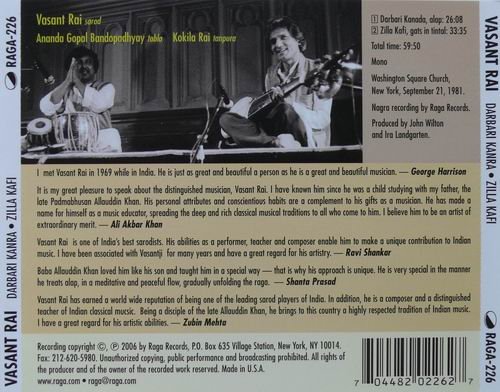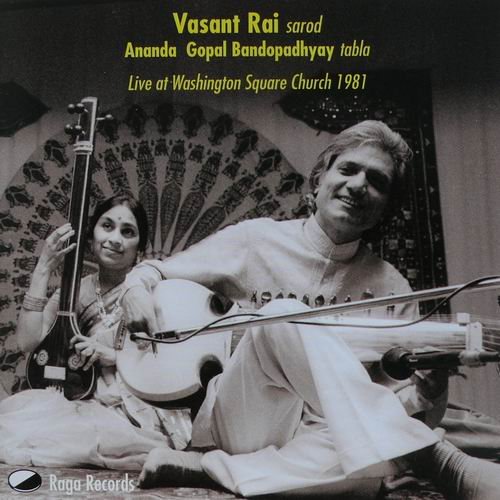
Vasant Rai, Anando Gopal Bandopadhyay - Live At Washington Square Church 1981 (2006)
BAND/ARTIST: Vasant Rai, Anando Gopal Bandopadhyay
- Title: Live At Washington Square Church 1981
- Year Of Release: 2006
- Label: Raga Records[RAGA-226]
- Genre: World, Folk
- Quality: FLAC (image + .cue,log,scans) | MP3/320 kbps
- Total Time: 59:47
- Total Size: 172 MB(+3%) | 141 MB(+3%)
- WebSite: Album Preview
Tracklist
01. Raga Darbari Kanada
02. Raga Zila Kafi

personnel :
Vasant Rai - sarod,
Ananda Gopal Bandhopadhyay - tabla
Kokila Rai - Tambura [Tanpura]
Until his death at the young age of 43 in 1985, Vasant Rai was one of the world’s most acclaimed masters of Indian music. Born in Unjha, in the province of North Gujarat, India, in 1942, he began musical education at age seven. He studied vocal music with his father, Govindji Brahmbhatt, and instrumental music with his elder brother, Kantilal. Vasant became proficient on sitar, violin, and flute, and appeared in his first concert at age 11. In 1958, after 13 years of musical experience, Vasant became the disciple of the incomparable guru Ustad Allauddin Khan, and was the last student to receive the Indian maestro’s complete musical training. He emerged a virtuoso on the sarod. The sarod is a 25-string fretless lute. Developed during the Mughal period of India’s history, the modern sarod has a body of seasoned teakwood, a goat skin belly, a highly polished metal fingerboard, and is plucked with a plectrum made from horn or coconut. Like its relative the sitar, the sarod’s first four strings carry the melody. In addition to three chikari strings, which have drone and rhythmic accompaniment functions, there are three other support strings that serve a similar purpose. Fifteen additional strings, the taraf, act as sympathetic resonators. Like the sitar, the sarod is a delicate, highly sophisticated instrument that is extremely difficult to master. Vasant studied and practiced under the strict guidance of Ustad Allauddin Khan, residing in his house, for eight years. He taught at the renowned master’s famed Music College in Maihar. Between 1964 and 1970, Vasant was given several important awards for musical excellence. In 1972, Vasant became a visiting professor of music at Columbia University in New York City. He subsequently founded the Alam School of Indian Classical Music in New York, where he taught sarod, sitar, flute, violin, guitar, and voice. He lived in the Chelsea district of New York City infuencing many Western musicians, while carrying on the pure classical tradition of his guru. His son Satyam is an accomplished sarod player, and his daughter Sangita a Kathak dancer. Vasant also explored new directions. “I am a musician,” he said. “I’m following the traditional ways, but I’m not orthodox to the point where I won’t do other things.” He appeared with electric guitarists Carlos Santana and John McLaughin (in 1974), and was perhaps best known for his remarkable series of “East-West blends” on the Vanguard label—compositions and improvisations recorded with members of the group Oregon. Towards the end of his life, Vasant experimented with the sur-guitar, a fretless sarod-guitar hybrid of his own invention.
01. Raga Darbari Kanada
02. Raga Zila Kafi

personnel :
Vasant Rai - sarod,
Ananda Gopal Bandhopadhyay - tabla
Kokila Rai - Tambura [Tanpura]
Until his death at the young age of 43 in 1985, Vasant Rai was one of the world’s most acclaimed masters of Indian music. Born in Unjha, in the province of North Gujarat, India, in 1942, he began musical education at age seven. He studied vocal music with his father, Govindji Brahmbhatt, and instrumental music with his elder brother, Kantilal. Vasant became proficient on sitar, violin, and flute, and appeared in his first concert at age 11. In 1958, after 13 years of musical experience, Vasant became the disciple of the incomparable guru Ustad Allauddin Khan, and was the last student to receive the Indian maestro’s complete musical training. He emerged a virtuoso on the sarod. The sarod is a 25-string fretless lute. Developed during the Mughal period of India’s history, the modern sarod has a body of seasoned teakwood, a goat skin belly, a highly polished metal fingerboard, and is plucked with a plectrum made from horn or coconut. Like its relative the sitar, the sarod’s first four strings carry the melody. In addition to three chikari strings, which have drone and rhythmic accompaniment functions, there are three other support strings that serve a similar purpose. Fifteen additional strings, the taraf, act as sympathetic resonators. Like the sitar, the sarod is a delicate, highly sophisticated instrument that is extremely difficult to master. Vasant studied and practiced under the strict guidance of Ustad Allauddin Khan, residing in his house, for eight years. He taught at the renowned master’s famed Music College in Maihar. Between 1964 and 1970, Vasant was given several important awards for musical excellence. In 1972, Vasant became a visiting professor of music at Columbia University in New York City. He subsequently founded the Alam School of Indian Classical Music in New York, where he taught sarod, sitar, flute, violin, guitar, and voice. He lived in the Chelsea district of New York City infuencing many Western musicians, while carrying on the pure classical tradition of his guru. His son Satyam is an accomplished sarod player, and his daughter Sangita a Kathak dancer. Vasant also explored new directions. “I am a musician,” he said. “I’m following the traditional ways, but I’m not orthodox to the point where I won’t do other things.” He appeared with electric guitarists Carlos Santana and John McLaughin (in 1974), and was perhaps best known for his remarkable series of “East-West blends” on the Vanguard label—compositions and improvisations recorded with members of the group Oregon. Towards the end of his life, Vasant experimented with the sur-guitar, a fretless sarod-guitar hybrid of his own invention.
World | Indian / भारतीय संगीत | Folk | FLAC / APE | Mp3 | CD-Rip
As a ISRA.CLOUD's PREMIUM member you will have the following benefits:
- Unlimited high speed downloads
- Download directly without waiting time
- Unlimited parallel downloads
- Support for download accelerators
- No advertising
- Resume broken downloads



